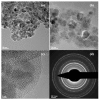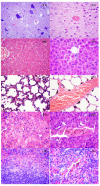Biocompatible Fe3O4 increases the efficacy of amoxicillin delivery against Gram-positive and Gram-negative bacteria
- PMID: 24759068
- PMCID: PMC6270688
- DOI: 10.3390/molecules19045013
Biocompatible Fe3O4 increases the efficacy of amoxicillin delivery against Gram-positive and Gram-negative bacteria
Abstract
This paper reports the synthesis and characterization of amoxicillin- functionalized magnetite nanostructures (Fe3O4@AMO), revealing and discussing several biomedical applications of these nanomaterials. Our results proved that 10 nm Fe3O4@AMO nanoparticles does not alter the normal cell cycle progression of cultured diploid cells, and an in vivo murine model confirms that the nanostructures disperse through the host body and tend to localize in particular sites and organs. The nanoparticles were found clustered especially in the lungs, kidneys and spleen, next to the blood vessels at this level, while being totally absent in the brain and liver, suggesting that they are circulated through the blood flow and have low toxicity. Fe3O4@AMO has the ability to be easily circulated through the body and optimizations may be done so these nanostructures cluster to a specific target region. Functionalized magnetite nanostructures proved a great antimicrobial effect, being active against both the Gram positive pathogen S. aureus and the Gram negative pathogen E. coli. The fabricated nanostructures significantly reduced the minimum inhibitory concentration (MIC) of the active drug. This result has a great practical relevance, since the functionalized nanostructures may be used for decreasing the therapeutic doses which usually manifest great severe side effects, when administrated in high doses. Fe3O4@AMO represents also a suitable approach for the development of new alternative strategies for improving the activity of therapeutic agents by targeted delivery and controlled release.
Conflict of interest statement
The authors declare no conflict of interest.
Figures












References
-
- Centers for Disease Control and Prevention Antibiotic Resistance Questions & Answers. [(accessed on 6 June 2009. Retrieved December 2013)];Get Smart: Know When Antibiotics Work Homepage. Available online: http://www.cdc.gov/getsmart/antibiotic-use/antibiotic-resistance-faqs.html.
-
- Cartelle M., del Mar Tomas M., Molina F., Moure R., Villanueva R., Bou G. High-level resistance to ceftazidime conferred by a novel enzyme, CTX-M-32, derived from CTX-M-1 through a single Asp240-Gly substitution. Antimicrob. Agents Chemother. 2004;48:2308–2313. doi: 10.1128/AAC.48.6.2308-2313.2004. - DOI - PMC - PubMed
Publication types
MeSH terms
Substances
LinkOut - more resources
Full Text Sources
Other Literature Sources
Medical

